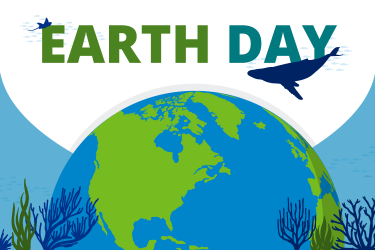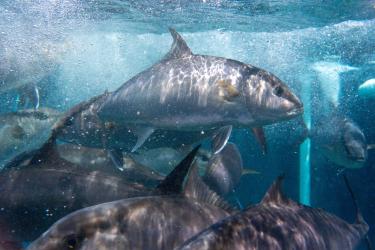Sustainable aquaculture expands opportunities for access to seafood—and for partnerships between groups who have a shared interest in sourcing quality ingredients with minimal environmental impact. In their ongoing search for sustainable, affordable, delicious items to add to the menu, chefs are developing a unique awareness of aquacultured, or farmed, seafood.
At this year’s Northeast Aquaculture Conference and Exposition, NOAA’s Community of Practice for Aquaculture Literacy hosted a panel to discuss shared goals across culinary, education, industry, and policy sectors. Panelists included:
- Barton Seaver, Chef, Seafood Literacy Educator and Cookbook Author, BartonSeaver.com
- Chris Schillaci, Regional Aquaculture Coordinator, NOAA Fisheries Office of Aquaculture
- Dan Ward, Aquaculture Farmer and Researcher, Ward Aquafarms
- Jeremy Sewall, Chef, Writer, Owner of Row 34
- Maggie Allen, Education and Grants Specialist, NOAA Office of Education
- Mark Rath, Aquaculture Manager, National Sea Grant Office
The panel discussion made clear that it can be difficult for consumers to access up-to-date information about the sustainability efforts of seafood farmers and regulators. One unexpected solution comes in the form of chefs, who connect with communities through their menus and culinary education programs to improve aquaculture literacy. NOAA provides financial and technical support to enhance these efforts.
Increasing Aquaculture Literacy
Aquaculture literacy is a community’s familiarity with information about aquaculture and related environmental, economic, and social topics. Aquaculture literate community members are knowledgeable about contemporary aquaculture practices and how they may relate to their community. They use their knowledge to make informed and responsible decisions regarding aquaculture and its products, and share that knowledge within the community.
One barrier to enhancing public aquaculture literacy is that consumers are often unaware of where to find credible information. During the panel, Chris Schillaci, a Regional Aquaculture Coordinator for the NOAA Fisheries Greater Atlantic Region, noted that a lot of information available to consumers is outdated. He said, “We are up against a lot of news stories that talk about data that’s 20 years old, or information from other countries that don’t highlight the incredible science and robust review that goes into permitting farms.”
Chefs reach many audiences in their regular interactions with people at every level of the farm-to-table supply chain. Panelists highlighted partnerships that merge outreach and communications strategies with the storytelling and cooking expertise of chefs. They provide a credible channel about how, and where, to find sustainably farmed seafood.
Bridging the Gap for Regulators and Farmers
For farmers like Dan Ward, owner of Ward Aquafarms in Massachusetts, the outdated information that Schillaci mentioned can hinder his ability to forge meaningful connections with his community. “I think most people don’t realize what we have to go through to get a new [farm] site,” Ward shared, “whether we’re getting permission at the local, state, or federal level. I think most people don’t understand the scope of the review that actually happens before a farm is permitted.”
In an effort to help contribute to, and communicate, the sustainability benefits of his farms, Ward offers educational farm tours, researches new technologies through NOAA funding. He also supports local science fairs and their students. Schillaci and Ward still see opportunities for more collaborative efforts to tell these stories in engaging ways.
Putting Seafood on the Table
From consumers to restaurant suppliers, chefs are uniquely positioned to share the stories of seafood farming across diverse audiences. Jeremy Sewall, owner of Row 34 restaurants, shared how something as simple as one sentence on his menu can have an impact. “[Row 34] may be the first time that someone has read about different farmed shellfish, integrated multi-trophic aquaculture systems, or whatever it might be,” said Sewall, “and that creates an opportunity for dialogue.” Sewall’s cookbooks also share educational information about seafood. This exposes readers to topics beyond the recipes such as farming techniques and environmental conditions that impact the taste of oysters.
Chefs Teaching Chefs
Seaver and Sewall noticed that culinary education lacked even basic information about working with seafood. This inspired both chefs to teach a foundational seafood program at The Culinary Institute of America. Seaver also offers a seafood literacy course for chefs. He works with partners like NOAA to incorporate credible, up-to-date, information about seafood farming practices that is engaging to chefs.
Back at his restaurants, Sewall encourages his staff to join him on the fish piers and seafood farms. They learn about working waterfront practices and then communicate about them to their customers. Thanks to the efforts of chefs like Seaver and Sewall, more members of the service industry are becoming familiar with seafood farming and its benefits.
Aquaculture Education at Work
Schillaci and NOAA Aquaculture Manager Mark Rath see opportunities for their work at NOAA to incorporate a chef’s approach to knowledge transfer—connecting over good food. When communicating NOAA’s sustainable aquaculture work, it can be challenging to overcome the misconception that seafood farming will outcompete wild-caught fisheries. But as they see it, sustainable aquaculture can and should co-exist with wild-capture fisheries. “We see space on everybody’s plates for sustainable seafood from all corners,” says Rath. “Domestic aquaculture is just one tool for feeding people that we want to see made more common.”
Moving forward, NOAA will continue supporting cross-sectoral aquaculture literacy partnerships that help working waterfront communities get to know their local seafood farming stories and opportunities. As Seaver puts it: “Once we see a fishery or an aquafarm as a reflection of ourselves—as the sum of the labors of aspirations of a community—then we begin to see ourselves reflected in the products that they produce."



